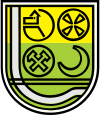Zenica
|
Zenica Зеница |
||
|---|---|---|
| City | ||

City of Zenica
|
||
|
||
| Location within Bosnia and Herzegovina | ||
| Coordinates: 44°12′05″N 17°54′23″E / 44.20139°N 17.90639°ECoordinates: 44°12′05″N 17°54′23″E / 44.20139°N 17.90639°E | ||
| Country | Bosnia and Herzegovina | |
| Canton | Zenica-Doboj | |
| Government | ||
| • Mayor | Fuad Kasumović (Independent) | |
| Area | ||
| • City | 558.5 km2 (215.6 sq mi) | |
| Elevation | 316 m (1,037 ft) | |
| Population (2013) | ||
| • City | 73,751 | |
| • Density | 206/km2 (206/sq mi) | |
| • Urban | 115,134 | |
| Time zone | CET (UTC+1) | |
| • Summer (DST) | CEST (UTC+2) | |
| Postal code | 72000 | |
| Area code(s) | (+387) 32 | |
| Website | www |
|
Zenica (Bosnian pronunciation: [zɛ̂nitsa]) is the fourth-largest city in Bosnia and Herzegovina, and the capital of the Zenica-Doboj Canton of the Federation of Bosnia and Herzegovina entity. Zenica is located about 70 km (43 mi) north of Sarajevo and is situated on the Bosna river, surrounded by a mountainous and hilly landscape. The city is home to 115,134 inhabitants as of 2013.
Zenica was an important economic and military center during the Banate of Bosnia and the Kingdom of Bosnia, and one of the relics from these eras is the Vranduk fortress. The city's old quarter contains several attractions, including the former synagogue, dating from 1906, which is now part of the City Museum. There is also a mosque, an Austrian fountain and an old bey's farm house (Hadžimazića Kuća).
The urban part of today's Zenica was formed during several specific periods which can be chronologically dated to the time of Neolithic community, Illyrian old towns ruins, Roman Municipium Bistua Nova, and the most important archaeological finding; an early Christian double basilica dating from the 2nd to 4th century, one of two that have so far been identified in Europe. Ruins of a substantial ancient settlement were found not far from Bilimišće (a suburb on the south side of the town) and close by the villages of Putovići and Tišina, with sites like a Villa Rustica, baths, pagan temples among other structures.
Known by the Romans as Bistua Nova, the town became known as Bilino Polje (Bilin's Field), Brod and finally took its modern name of Zenica from 20 March 1436. During the Middle Ages, the town was important in the governance of the Bosnian Kingdom, in particular under Ban Kulin in the 12th Century. Nearby were the stone fortress of Vranduk, the residence of the Kings of Bosnia at Bobovac and the village of Janjici, where the Did, head of the Bosnian Church resided. The nearby villages of Puhovac and Pojske are the site of several Stećak tombstones, unique to Bosnia and Herzegovina and parts of Croatia, Montenegro and Serbia.
...
Wikipedia


